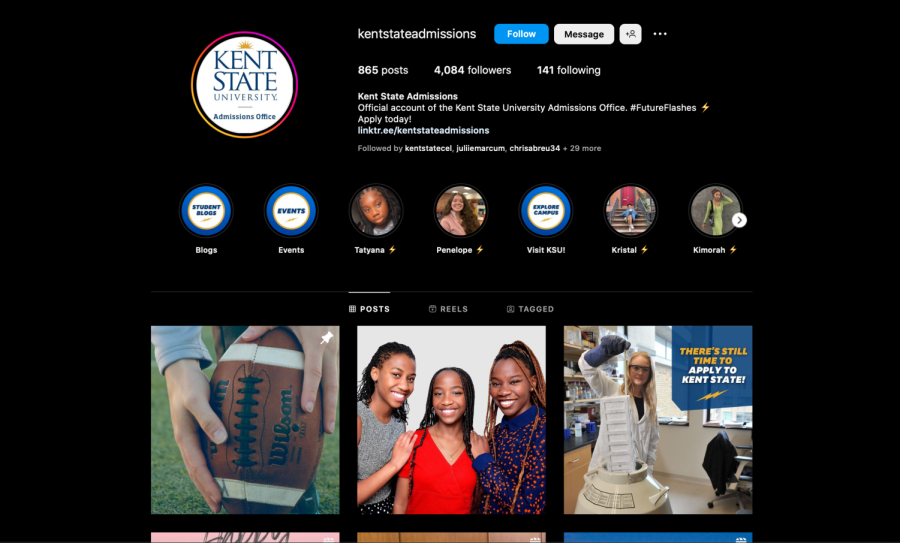Universities take to social media to combat enrollment declines
Courtesy of Kent State Admissions
The Kent State University Admissions Office Instagram page.
February 23, 2023
As college enrollment rates across the nation have declined over the past few years, higher education institutions have had to get creative to stop the downward trend.
One of the tactics used is to harness the power of social media and analyze the content’s effectiveness.
At many universities, the enrollment cliff is of genuine concern. From 2017 to 2018, enrollment at four-year universities declined by 2.4%, according to the National Student Clearinghouse Research Center.
Kent State adopted new strategies for its social media pages which have been implemented on its Instagram, TikTok, Twitter and Facebook accounts.
Erica Collins, a digital and social specialist at Kent State, focuses specifically on the admissions and recruitment side of social media.
She manages the admissions Instagram, Facebook and Twitter accounts and ensures that the content is organized, engaging and timely.
Collins also responds to students’ questions or concerns via direct messaging on the accounts.
Since social media is constantly changing, she adapts the content created and strategically posts it on specific platforms.
“Instagram and TikTok are the main student-focused audiences,” Collins said. “Students are really looking to connect with us, see student stories, see bits and pieces of campus life and what they can expect their college experience to be like if they come to Kent State.”
One of the more recent tactics used to recruit and retain is the student-to-student connection early on.

Sharing content that involves students talking about their experiences can help prospective students envision their success at Kent State.
“We see a lot of traction if we post a student story about a current student who had a really cool internship, or if they do an Instagram takeover for us and they’re sharing kind of a day in their life on campus,” Collins said.
While Collins and her team have seemingly found a temporary formula for keeping students engaged, she said reaching everyone within their desired audience is still challenging.
To reach parents and students, content is posted on numerous platforms; however, parents do not always reciprocate the same student engagement.
“I think one of our biggest challenges we face, and I think this goes for any university, is keeping up with how frequently the algorithms change and just adapting our content and strategy based on what’s currently popular and working,” Collins said.
Despite the challenge of getting parents interested, Collins encouraged student workers to be more involved in creating content that piques prospective students’ interest.
Doing so has helped create a line of communication between students, staff and faculty in an attempt to make the decision and enrollment process easier for prospective students.
Work is also done on the back end of recruiting and retaining students.
Fatima Habbiyyieh, a data analyst in the division of enrollment management, works with her team to find effective solutions and organize data.
Habbiyyieh and her colleague collect data daily on students who are enrolling, graduating and transferring.
When looking at the enrollment cliff, Habbiyyieh examines trends for students grouped into 2022 and 2023 cohorts.
“Now, if it’s decreasing, we like to look at why,” Habbiyyieh said. “So we look at factors such as if they’re an unrepresented student, which is usually a minority group, or they have a household income that’s on the poverty line, just however the financial aid department breaks that up.”
As universities work to level the curve, they continuously try to find innovative ways to grab students’ attention.
“Be sure that you’re following trends,” Collins said. “Be willing to experiment and see where your current audience is actually interacting with you.”
Alex Zito is a reporter. Contact him at [email protected].

























